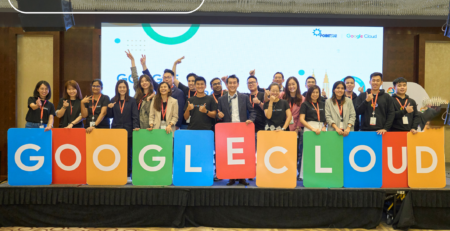Spaces create richer, more collaborative experience in hybrid work world
Syah Ismail2021-08-18T13:29:13+08:00
Over the last year, our collective understanding of work—where it takes place and how it gets done—has been transformed. As companies and organizations across the globe reimagine work, new challenges and opportunities are emerging. How do people working “somewhere else” stay connected and be part of the same conversations as those in the office? If hybrid work is the sum of all the places and ways that work happens, how do employees create a shared experience, better manage their time and attention, and build stronger connections along the way?
In 2020, Google launched Google Workspace as an integrated solution that provides everything you need to get anything done, all in one place. Recently, Google announced new forthcoming innovations in Google Chat to help teams do their best work in the hybrid work world, as many of us begin a return to the office. Google Chat has been an essential part of work during the last year, serving as a bridge for separated colleagues to collaborate in real-time. Later this year, Google will evolve the Rooms experience in Google Chat to Spaces, a dedicated place to organize people, topics, and projects in Google Workspace.
A dedicated space for teamwork and collaboration

Chat and video meetings have been an essential part of work during the last year, serving as a bridge for separated colleagues to collaborate in real-time. Over the summer, Google will evolve Rooms to become Spaces and launch a streamlined and flexible user interface that helps teams and individuals stay on top of everything that’s important.
In Spaces, you’ll notice new features like:
- In-line topic threading
- Presence indicators
- Assigned tasks
- Expressive reactions, custom statuses using emojis, and GIFs
- Improved content search across Spaces
- Message pinning
- User roles and moderation tools
- Discoverable spaces
Spaces can provide a place to fuel knowledge sharing and community building for teams of all sizes, where all the relevant information, conversations, and files for a project can be organized, and where topics—even at the organization level—can be intelligently moderated. With the ability to pin messages where everyone can see them, Spaces will play a crucial role in helping people stay connected and informed as hybrid work evolves.
Spaces will also seamlessly integrate with Calendar, Drive, Tasks, and across Workspace becoming a new home for getting more done, together. In Spaces, you’ll be able to:
- Create and share docs
- Side-by-side discuss and edit
- See status from calendar
- Run interactive polls
- Integrate workflows directly with Bots
For moments when you need to collaborate further, you can easily convert your group conversations into Rooms. In the future, you’ll be able to convert group conversations into Spaces when it becomes available.
The new experience will begin rolling out to all users of Chat in Gmail over the next several months for all organizations that have Chat enabled, with new features being delivered on a rolling basis.

In the coming months, we will introduce a new streamlined and flexible user interface that helps people and groups more easily stay organized and balance focus and multitasking. The new experience will feature new left-hand navigation which surfaces critical applications like Gmail, Chat, and Meet in one location. This will make staying on top of and navigating to important conversations and critical notifications easier, eliminating the need to switch between various applications.
Keeping everyone in the conversation during hybrid meetings

Collaboration equity—the ability to contribute equally, regardless of location, role, experience level, language, and device preference—is a cornerstone of Google Workspace. When teammates were fully remote during the last year, everyone experienced meetings in much the same way and had access to the same communication features. But what happens when some colleagues are in a conference room together while others are joining from living rooms, home offices, or a remote co-working space? How do they all participate equally in the same conversation?
At Google I/O, Companion Mode in Google Meet was previewed as a way of fostering collaboration equity in a hybrid work world. Companion Mode is designed to seamlessly connect those in the room with their remote teammates, giving everyone advanced features to participate, while leveraging the best of in-room audio and video conferencing capabilities.
Companion Mode gives every meeting participant, no matter where they are, access to interactive features and controls like screen sharing, polls, in-meeting chat, hand raise, Q&A, live captions, and more. Colleagues who are in the same meeting room together will enable Companion Mode on their personal devices, giving them their own video tile in Meet and helping them to stay connected with their remote teammates. Companion Mode will be available on the web and the upcoming progressive web app in September, and it will be coming soon to mobile.

To allow meeting organizers to better plan for hybrid meetings, invitees will soon be able to RSVP with their join location, indicating whether they’ll be joining in a meeting room or remotely.
Updates to improve the in-room experience are also coming to Google Meet hardware in September, including the ability to see and use the hand-raise feature and receive notifications from polls and Q&As. The modular design of Meet’s Series One room kits can easily accommodate a variety of space layouts and be paired with an AV cart for optimum flexibility.
Google is also continually launching new controls to make meetings more safe and secure, including the ability for admins to set policies for who can join meetings, and how participants can engage within meetings. To help everyone stay focused in meetings without interruption, in the next few months Google will introduce moderation controls for hosts, giving them the ability to prevent the use of in-meeting chat and prohibit presenting during meetings, as well as allowing them full control to mute and prevent participants from unmuting.
Trusted hybrid collaboration in Google Workspace
Security, data privacy, and trust continue to be the foundation that makes anywhere, anytime collaboration possible. As organizations explore new ways for their teams to collaborate securely in a hybrid work world, Google is introducing new security and privacy capabilities to help Google Workspace customers realize the full power of trusted, cloud-native collaboration.
Google Workspace Client-side encryption will help customers strengthen the confidentiality of their data while addressing a range of data sovereignty and compliance needs. Additionally, Google is rolling out a number of security enhancements for Google Drive, including trust rules for Drive that help control how files can be shared within and outside your organization; Drive labels that classify files and apply controls based on their sensitivity levels; and enhanced phishing and malware protection to help safeguard against insider threats and user error.
A single, connected experience
As businesses move to a hybrid work environment, the importance of creating secure collaboration spaces and fostering human connection has never been more important. Since Google Workspace was designed to fuel anywhere, anytime collaboration, it is now helping millions of organizations navigate the challenges and opportunities of the newly emerging work model. With this change, all of Google Workspace’s 3 billion existing users across consumer, enterprise, and education now have access to the full Google Workspace experience, including Gmail, Chat, Calendar, Drive, Docs, Sheets, Meet and more.




